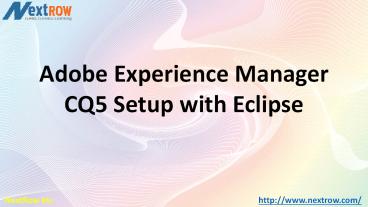Adobe CQ5 Setup with Eclipse PowerPoint PPT Presentation
Title: Adobe CQ5 Setup with Eclipse
1
Adobe Experience Manager CQ5 Setup with Eclipse
NextRow Inc
http//www.nextrow.com/
2
Below are the steps to set up workspace and start
development of CQ5 components in Eclipse
- Prerequisites
- CQ5 installation
- File Vault (VLT)
- Eclipse
- Apache Maven
NextRow Inc
http//www.nextrow.com/
3
Step 1
- Create a project in CQ5 using CRXDE LITE
- Under the /apps folder, create the ntfolder
myApp. - Under the myApp folder, create the ntfolder
components. - Under the myApp folder, create the ntfolder
templates. - Under the myApp folder, create the ntfolder
install. - Click save button after creating the above things.
NextRow Inc
http//www.nextrow.com/
4
Step 2 - Installing File Vault (FLT)
- In our file system, go to ltcq-installation-dirgt/cr
x-quickstart/opt/filevault. The build is
available in both tgz and zip formats. Extract
either of this two archives. - Add ltcq-installation-dirgt/crx-quickstart/opt/filev
ault/vault-cli-ltversiongt/bin to your environment
PATH so that the command files vlt or vlt.bat are
accessed as appropriate. For example,
ltcq-installation-dirgt/crx-quickstart/opt/filevault
/vault-cli-1.1.2/bin - Open a command line shell and execute vlt --help.
Make sure it displays the following help screen
NextRow Inc
http//www.nextrow.com/
5
NextRow Inc
http//www.nextrow.com/
6
Step 3
- Open eclipse by double clicking eclipse.exe
- Create a new workspace for your project and name
it myApp. - install maven plugin through eclipse market place
NextRow Inc
http//www.nextrow.com/
7
After installation, restart Eclipse.
NextRow Inc
http//www.nextrow.com/
8
Step 4
- In this section, we create two Maven projects
One called UI (after User Interface) which
contains the CQ5 project structure with the JSP
scripts and the other called Core which contains
the Java code (source and compiled). - The compiled code is stored in a jar file. The
advantage of such a structure is that it adds
modularity and autonomy to the logic of your
application because each jar file (bundle) can be
managed separately.
NextRow Inc
http//www.nextrow.com/
9
Follow the Below Steps
- In Eclipse, click File gt New gt Other.
- In the dialog, select Maven gt Maven Project and
click Next. - Select the Create a simple project option and the
Use default Workspace location option, then click
Next.
NextRow Inc
http//www.nextrow.com/
10
- Specify the following property values for the
Maven project, and accept the default values for
all other properties - Group Id com.day.cq5.myapp
- Artifact Id ui
- Name CQ5 MyApp UI
- Description This is the UI module
- Click OK.
NextRow Inc
http//www.nextrow.com/
11
Now, create the filter.xml file that defines the
content that VLT exports
- In the Project Explorer view, in the ui/src/main
folder, create the content folder. - Under content, create the META-INF folder.
- Under META-INF, create the vault folder.
- Under vault, create the filter.xml file.
NextRow Inc
http//www.nextrow.com/
12
Implementing Adobe Experience Manager? We can
Help. Contact Us
1-855-NEXT-ROW aem_at_nextrow.com www.nextrow.com
13
In filter.xml, copy the following code to
filter.xml
lt?xml version"1.0" encoding"UTF-8"?gt lt!--
Defines which repository items are generally
included --gt ltworkspaceFilter version"1.0"gt
ltfilter root"/apps/myApp" /gt ltfilter
root"/etc/designs/myApp" /gt lt/workspaceFiltergt
Now, save filter.xml
NextRow Inc
http//www.nextrow.com/
14
Step 5
Use VLT to check out the CQ5 content into your ui
project
- In the system command line, change the current
directory to the following directory in your
Eclipse workspace lteclipsegt/ltworkspacegt/myApp/ui/
src/main/content. - Execute the command vlt --credentials
adminadmin co http//localhost4502/crx - This command creates the folder jcr_root under
lteclipsegt/ltworkspacegt/myApp/ui/src/main/content.
This maps to the CRX root (/). Under jcr_root the
following files and folders are created, as
defined in filter.xml - apps/myApp
- etc/designs/myApp
- It also creates two files, config.xml and
settings.xml in lteclipsegt/ltworkspacegt/myApp/ui/src
/main/content/META-INF/vault. VLT uses these
files.
NextRow Inc
http//www.nextrow.com/
15
- In the ui Eclipse project, create a link to the
apps folder that you just checked out. This link
enables your JSP scripts to reference the files. - Right-click ui, select New, and then Folder.
- In the dialog box, click Advanced and select Link
to alternate location. - Click Browse, specify lteclipsegt/ltworkspacegt/myApp/
ui/src/main/content/jcr_root/apps, and then click
OK. - Click Finish.
NextRow Inc
http//www.nextrow.com/
16
If you need help with CQ setup or development,
reach me _at_
Kedarnath Varadi
kvaradi_at_nextrow.com
www.NextRow.com

